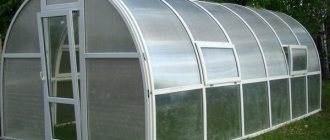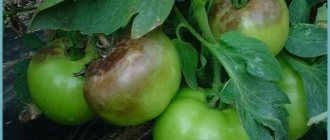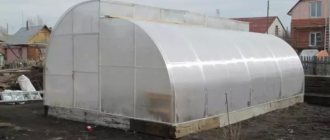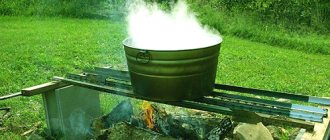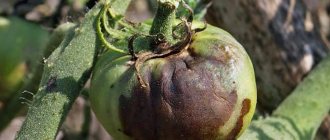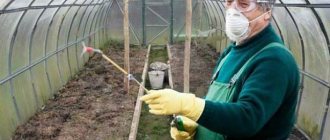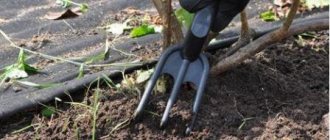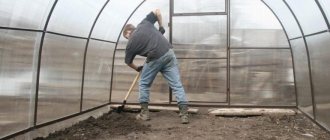With the first breath of spring, it is time to massively prepare greenhouses for the new season. Cleaning and whitewashing the greenhouse, its disinfection, as well as warming up and adding the components necessary for the earth - this is just an incomplete list of work awaiting gardeners during this period. But only timely and high-quality implementation can be a key factor in obtaining a decent harvest. Proper soil preparation in the spring in a greenhouse can significantly improve its performance.
Greenhouse prepared for planting
Why treat a greenhouse in the spring
After several years of operation of the greenhouse, pathogenic microbes and other microorganisms can live and multiply on its walls and in the soil. To protect the plants and not harm the crops, spring treatment of the structure is necessary.
During their growth, seedlings receive nutrients from the soil. Therefore, it is necessary to prepare the greenhouse correctly for the new season in the spring. Necessary:
- Inspect the greenhouse for damage. If they have been identified, eliminate them;
- carry out complete disinfection;
- fight pests whose habitat is in the ground;
- restore soil fertility.
You can protect the future harvest and the structure if you choose the right drugs to combat parasites and carry out the necessary procedures on time.
Useful tips
- If possible, the soil in the planting containers should be replaced. And be sure to check the acidity level, even if the soil was purchased at a specialty store. You may have to add something to the soil.
- An increase in productivity is facilitated by early spring sederation (a separate topic; it is worth paying attention!), as well as compliance with the rules of crop rotation (if last year’s land is used).
- Some types of microbes can be eliminated by adding manure or compost. But planting on such plots will have to wait.
- “Improvement” of the soil can be done by a sharp change in temperature - pour boiling water on it or, conversely, add snow.
Good luck with your own dacha!
When to treat
Treatment of the greenhouse in the spring should begin before the snow melts - it should be brought in and covered with it over the entire area of the soil. For initial procedures, its role cannot be overestimated. Benefits of using snow:
- melt water penetrates the soil, saturating it with useful microelements;
- Because of the snow, the ground freezes, which leads to the death of pests that have not yet awakened.
Attention! You can get rid of ice from polycarbonate if you open all windows and doors at sub-zero temperatures. When the temperature levels out, the crust will be easy to remove.
In the last winter month, the soil needs to be cleaned and disinfected. In addition, greenhouses need treatment. In particular, if wooden parts are rotten, then replacing them is impossible. Metal structures that have become corroded should:
- clear;
- treat to get rid of rust;
- apply primer;
- paint.
You can use folk remedies for these purposes.
Cleaning
First, the greenhouse must be cleared of snow from the outside. Remove snow and ice from external walls and panels. Clear the perimeter around the structure of debris and unnecessary things at a distance of up to 2 m around the perimeter. I recommend covering this space with strips of dark-colored film.
I advise you to start snow removal from the upper parts of the structure, gradually lowering to the ground. If the design of the greenhouse allows, then the remaining snow cover should be removed by shaking the walls or gently tapping them.
If the greenhouse is made of glass or polycarbonate, then you should not remove snow with a shovel or stick. To ensure that this coating remains intact and undamaged, I recommend using a soft broom, broom, or floor brush.
Stages of preparing a greenhouse for the season
In order to properly treat the greenhouse for spring sowing, a lot needs to be done. In addition to preparing the soil, you need to wash and disinfect the structure itself, which can become a breeding ground for bacteria and pests.
Freeing up space
Before starting work on processing the greenhouse, you will have to remove everything from it that could interfere with this process. Even the supports that support the roof in the event of a large amount of snow must be dismantled.
Everything that is taken out of the greenhouse must be carefully inspected and processed:
- Whitewash wooden structures with lime and paint glue. If the elements are rotten, they require replacement;
- treat metal products from rust if pockets of rust have been identified. This can be done using both folk remedies and purchased ones. After this manipulation, paint the metal supports.
Attention! If heating equipment is installed in the greenhouse, it needs to be painted. However, it is not recommended to use oil paint - it reduces heat transfer.
If everything that was taken out is not damaged, then you can refuse processing
Garbage collection and recycling
Be sure to get rid of last year's weeds, ropes and pegs that were used by gardeners to tie up vegetable crops. Roots, leaves, and stems of plants also need to be removed.
Collected garbage must be burned. At the same time, the ash that will be obtained during the recycling process will be an excellent fertilizer. It will help saturate the earth with useful microelements (zinc, phosphorus, iron, etc.). If you use dry ash for fertilizer, then it must be scattered before digging the soil at the rate of 3-5 cups per 1 square meter. m. If for feeding, then you need to dissolve 1 glass of the substance in a bucket of water.
Fighting dust and dirt
It is necessary to provide clean conditions for growing seedlings and vegetable crops by washing the greenhouse. You need to remove dirt and layers of dust with:
- frame. It is treated with a soap solution, then it is collected back with a rag. If there was an invasion of parasites in the previous season, then a remedy for the detected pests should be added to the solution;
- polycarbonate plates, while they are processed on both sides. For washing, use a soft rag or sponge with soapy water. From the outside it can be washed off with high pressure of water, but inside you need to do this carefully - it is undesirable for soap to get into the ground.
If you follow these rules, you can clean the greenhouse without harming the soil.
Greenhouse disinfection
After the greenhouse has been washed, you need to start disinfecting it. Bordeaux mixture is used to combat diseases. Some gardeners who prefer folk remedies to combat diseases and pests resort to a decoction of pine needles.
You need to prepare it as follows: fill the bucket halfway with pine branches, add liquid. When this remedy is infused, it can be used. To quickly prepare this product, you can cook it for 20 minutes. Summer residents can also replace pine needles with nettles - the preparation of the decoction is similar. If the greenhouse is severely damaged by fungal infections, then you can resort to fumigation.
Attention! Before this procedure, all the cracks in the greenhouse must be sealed so that the vapors of the product used do not evaporate into the air.
Fumigation is often done by gardeners, since this way they can treat the soil and the structure itself.
Preparing the soil for planting
Disinfection methods acting on the frame make it possible to reduce labor costs for soil cultivation. According to the rules, you need to change its top layer (the first 12-15 cm) with a new one every year. But there are alternative replacement methods:
- tilling the land with boiling water - per 1 sq. m. requires 3 buckets of liquid;
- pour boiling water and cover the soil. The resulting steam penetrates deeply, destroying pests;
- soil disinfection with a 1% solution of potassium permanganate or a 3% solution of nitrafen. This will help exterminate insects hibernating in the soil;
- disinfection with carbation at a concentration of 2%.
Other chemicals are best used in the fall.
Let's finish what we didn't get done in the fall
Let's start with events that are preferably carried out in the fall, but due to circumstances can be done in the spring. Conscientious and diligent summer residents who do everything according to the rules can skip this point.
To begin with, we remove plant residues, equipment and garbage from the greenhouse. If temporary trellises were installed from twine or slats, then everything should be disassembled and also removed. All waste from the greenhouse must be burned. Activities to clean and prepare the greenhouse should begin before positive night temperatures set in. The sooner the greenhouse is ready, the faster the soil in it will warm up.
Next, we remove the top layer of soil about 10 cm thick and transport it outside the greenhouse. It is in this layer that the main amount of infection and overwintering phases of pests are concentrated.
The frame and covering of the greenhouse (film, glass or polycarbonate) need to be thoroughly washed with water under pressure from a hose to remove dirt and debris.
It is also recommended to apply basic fertilizers and humus in the fall. However, this can be done in the spring in parallel with other soil preparation operations.
How to fertilize the soil in a greenhouse in spring
When sowing seeds, you can use any fertilizer. For small households, it is better to use natural or organic fertilizer. In particular, phosphorus fertilizers can be replaced with bone meal.
It must be sprayed over the beds and sealed in place using a hoe or flat cutter. After such fertilization, you need to water and cover the soil.
Manure is often used to increase soil fertility. But it can be replaced with the following mixtures:
- turf soil and peat - in a ratio of 1 to 3;
- peat, sawdust, mullein – 3:1:0.5;
- ammonium nitrate, superphosphate, potassium chloride;
- phosphorus and potassium;
- bird droppings. Dissolve 1 matchbox with these contents in a 10 liter bucket of water.
Mix the components of the last solution well and let it brew for a day.
Signs of lack of fertilizer
The lack of one or another element in a plant can be determined by the following signs:
- Nitrogen: pale, sometimes yellowish, pinkish tops. The plant itself is developing slowly. The leaves are small, deformed, and may curl and fall off.
- Phosphorus: the tops acquire an unnatural purple, bluish tint, individual leaves curl upward.
- Potassium: burns appear along the edges of the leaf blades. The greenery itself becomes deformed and curls downwards. If the plant blooms, its buds dry out and fall off without producing a fruit.
- Magnesium: a deficiency of the element is indicated by yellowing of the leaves around the edges.
- Copper: the sheet plate unnaturally fades to almost white.
- Zinc: foliage becomes small, pointed, and covered with dark spots.
If it is difficult to determine the lack of a certain element, I advise you to carefully use a complex composition.
How to prepare the soil in a greenhouse in spring
Basically, the beds begin to be prepared for spring planting in the fall. During this period, the soil is fertilized, mulched with small branches and residues from plant tops. If these procedures were carried out in the fall, then nothing more needs to be done in the spring.
Mulching the soil in a greenhouse
To fertilize the soil in the fall, gardeners use mineral and organic fertilizers. This task can be accomplished by mulch made from crushed tops of weeds and vegetables. A layer of these products is placed on the beds; digging is not necessary.
This is due to the fact that mulch retains necessary moisture in the soil. If you don’t dig up the soil, you can simply loosen it.
Sowing green manure
To increase the fertility of beds, various means are used, including mustard and oilseed radish. Sowing such green manures is accompanied by the following rules:
- the soil must be prepared - fertilized in the fall, loosened without turning the top layer. Loose soil is the best springboard for their emergence and growth;
- no beds or furrows are needed for sowing;
- Water the seeds and cover.
In those beds where mustard grew, there is no need to use nitrogen fertilizers.
Compost
Compost is a name given to various mixtures of organic fertilizers. Mineral additives are also added here, as well as ash or lime. To make such a mixture, all the components are dumped in one place, water or liquid manure is added on top, mixed well and stacked in piles about two meters high.
Compost is prepared in the summer. It must be stirred several times during the summer and also ensure that it does not dry out, adding water as needed.
In winter, the compost heap must be protected from frost. To do this, a protective barrier is created around it: dry straw, a peat layer, fallen dry leaves, and sawdust is also suitable.
It takes about a year or a little more for the compost mixture to become ready. How do you know when the mixture is ready? In appearance, it should be black, soft and uniform, without large lumps or plant debris.
Compost pile
To increase the looseness of greenhouse soil, composts with wood waste are used: sawdust, shavings, wood chips and bark. All these elements must be mixed with inorganic fertilizers (urea, superphosphate) and placed in a heap. After a few months, you can already add compost.
Methods for disinfecting greenhouses and soil
To cultivate the soil and polycarbonate greenhouse in the spring before planting seeds or seedlings, different methods are used. This must be done in order to exterminate fungal infections and pests overwintering in the soil or on the walls of the structure. Popular methods are biological, chemical and temperature.
Biological
More and more gardeners and farmers decide to process the polycarbonate greenhouse in the spring using a biological method. To do this, you should purchase a special preparation, dilute it and treat the soil with the resulting solution. This method is inferior in efficiency to chemicals, but the harvest will be environmentally friendly.
Attention! When using biological agents for treatment for the purpose of prevention, the effect of their action will be much higher.
Preparations that do not contain dangerous chemical compounds can destroy pests and increase yield. There cannot be an overdose, but fertilizers must be applied to moist, warm soil.
Chemical
Gardeners resort to the use of special means if they need to disinfect structures and plants. Chemicals will save time during this procedure. But there is one significant drawback: they penetrate deep into the soil, vegetables, fruits, berries, etc.
The range of such products is wide, so you need to choose the one that will solve the problem.
Temperature method
This method of soil treatment is simple - it is based on the effects of high and low temperatures. In the second case, the greenhouse is opened during cold weather without covering the soil with snow. Frost can destroy parasite larvae that live in the soil and can harm future plants.
The steaming procedure will also help disinfect the soil. For this purpose, it is poured with plenty of boiling water.
Attention! The volume of liquid can be up to 100 liters.
After completing this manipulation, the ground must be covered so that all moisture remains in it. Approximately 80% of dangerous microorganisms will die under the influence of steam.
Complex mineral supplements
(adsbygoogle = window.adsbygoogle || []).push({});
- wood ash,
- potassium nitrate,
- nitroammophoska,
- carbonate nitrophoska,
- microfertilizers.
Wood ash
It contains many important elements, such as iron, silicon, potassium, sulfur, calcium, phosphorus and others. Ash is ideal for treating acidic soil. Add to the soil during off-season periods. It has a beneficial effect on the soil for a long time (more than two years).
Wood ash
Potassium nitrate
Contains nitrogen and potassium. It looks like a powder of yellow-gray crystals. Suitable for acidic soil, applicable for all types of vegetables. Well suited for liquid feeding of roots.
Nitroammofoska
Potassium and nitrogen supplements are contained here in equal parts. Powder in granules, it is convenient to make an aqueous solution from it. Can be added to different types of soil and for any seedlings. It is applied when feeding plants or when digging the soil.
Carbonate nitrophoska
Contains the same elements, but potassium in a small dose. It looks like granular powder. The soil is enriched with this fertilizer before sowing vegetables. Can be used in liquid form to feed roots.
Secrets of growing vegetables in heated greenhouses
Microfertilizers
Such soil mixtures contain: components with zinc, boron, molybdenum, manganese, copper. They are needed for seedlings in small quantities, but their shortage significantly affects the yield. Be sure to use microfertilizers. They are usually combined with inorganic elements, as well as ash components or peat.
It is necessary to use each type of additive, both organic and mineral, depending on the variety of crops that you are going to plant in the greenhouse. Of course, it is worth taking into account the characteristics of the soil. Try everything experimentally, gradually choosing exactly the composition of fertilizers that is specifically suitable for plants.
How and with what to properly treat a greenhouse against diseases
Pathogenic microorganisms can hide in the soil and in the greenhouse. Therefore, the entire structure needs to be processed. To do this, gardeners resort to different methods, both folk and chemical.
Fitosporin
This product is used to destroy late blight. This infection develops in humid and warm climates. If you do not treat the greenhouse in the spring, the entire tomato crop may die.
You can buy phytosporin in the form of liquid, powder and paste. If the solution was prepared correctly, it can be stored for 12 months in a cool, dark place.
To more effectively combat late blight, you can prepare a solution with phytosporin and other means. For a bucket of water you will need:
- 4 tbsp phytosporin solution;
- 3 tbsp. hydrogen peroxide;
- 10 metronidazole tablets.
The resulting solution can be used to treat soil and greenhouses. This disinfection must be carried out every 10 days throughout the season.
Sulfur checker
Using this product 1-2 times during the season will help you forget about diseases and parasites. But the sulfur bomb has one big drawback - both dangerous and beneficial microorganisms die.
They are produced in the form of tablets, which are equipped with a wick. To process a greenhouse, you need to put the required number of tablets into it and light the wick. During the procedure, all openings of the greenhouse must be tightly closed.
Attention! The structure should be treated with this method only 14 days before planting vegetable crops.
To use a sulfur bomb, certain conditions must be met:
- the temperature in the greenhouse should be at least 10 degrees Celsius with a plus sign;
- the soil should be dry at a depth of 10 centimeters.
You need to think before using this product, as it reduces fertility and causes corrosion of metal products.
Copper sulfate
With the help of this solution, summer residents destroy fungal infections. Spring treatment of the greenhouse with copper sulfate will not only get rid of the fungus, but also the larvae of parasites.
I have been using this solution for a long time to prevent and combat diseases. The concentration of the finished product depends on this. In the first case, 75 g of the drug must be diluted in a bucket of water, and if outbreaks of infections have been noticed, then the proportion increases to 150 g per bucket of water.
To work with copper sulfate, personal protective equipment is required. Treatment with this solution should be carried out no earlier than a month before planting begins. In this case, the air temperature in the greenhouse should be no less than 10 and no more than 15 degrees Celsius with a plus sign.
Potassium permangantsovka
Potassium permanganate is used to treat the soil before sowing. Every year you don’t have to change the top layer of soil, but it’s better not to neglect disinfection. Using potassium permanganate for these purposes has the following advantages:
- extermination of pathogens;
- stimulation of biological processes;
- pest control.
Attention! Manganese solution is only suitable for treating peat, turf and black earth soil.
Always prepare a fresh solution of potassium permanganate. For 10 liters of liquid, 5 g of manganese crystals is sufficient.
Bordeaux mixture
This remedy is prepared from a solution of copper sulfate and diluted lime. Preparation:
- Dilute copper sulfate in a small amount of water at a temperature of 50 degrees, mix thoroughly;
- add more liquid to obtain the required volume;
- dilute slaked lime in water;
- mix the two resulting solutions.
For processing 1 sq.m. you need 10 liters. Bordeaux mixture is used to combat fungi and bacteria that grow on plants.
White
In summer, an organic coating forms on the walls of the greenhouse, which must be removed. If this is not done, bacteria will begin to multiply in it. This will lead to plant diseases, and the crop will not be stored for a long time.
You can avoid such consequences if you use white to kill bacteria. It can also be used to disinfect gardening equipment.
Whiteness is an excellent antiseptic, but it is better to refrain from using it to treat the soil and wash a polycarbonate greenhouse.
Laundry soap
Vegetable growers often do not welcome the use of chemicals. To treat greenhouses they use laundry soap, preferably a 72% bar. It needs to be grated and added to a container with warm liquid. Next, you need to mix well until completely dissolved.
The resulting mixture should be applied to walls, wood and metal products for 120 minutes. After this time, it must be washed off with water. The procedure must be performed carefully so that the solution does not get on the soil.
Farmayod
The drug is used to combat all types of infections and pests. It is available in liquid form. To treat a polycarbonate greenhouse in the spring before planting, you need to use a sprayer.
Application of Pharmaiod:
- You need to fill the sprayer with liquid and add the drug to it. The proportions are indicated in the instructions;
- Pharmaiod is thick, so it needs to be shaken to completely dissolve;
- use of the product requires personal protection.
Attention! After treating the greenhouse with Pharmaiod, it must be tightly closed and not entered for 4 days.
After this period has expired, you can begin planting work.
Handling Precautions
Basically, chemicals are used to disinfect a greenhouse, so when working with them you need to follow certain rules. This is necessary to avoid poisoning.
- When making mixtures for processing polycarbonate greenhouses in the spring and working with them, be sure to use protective equipment: gloves, goggles, masks or respirators, gowns, etc.
- Smoking, drinking and eating are prohibited in the building where chemicals are stored.
- After finishing the treatment, ventilate and wash the clothes the gardener was wearing.
- Wash exposed areas of the body thoroughly under water.
- Rinse your mouth and nose.
If a greenhouse is treated with a sulfur bomb, then you need to exit the structure immediately after lighting the wick. You cannot enter it for several days.
Tilling the soil and greenhouse are important steps before starting gardening work. Therefore, you need to approach these procedures responsibly, following all recommendations.


